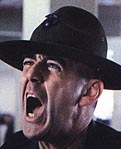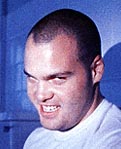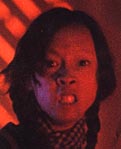


in Full Metal Jacket
by Jennifer Menzel
__________________________________________________
The Vietnam War was a time of protest and chaos for much of American society. The film maker Stanley Kubrick chooses to depict some of this time in his film entitled Full Metal Jacket. Kubrick utilizes many film techniques to create symbolic imagery. There are many social ideals and beliefs that Kubrick deals with in his movie, such as the controversy of racism, gender, and religion.
The use of racism is mentioned throughout the movie as a tool for defining the marine character. It is first seen in the movie when the recruits are introduced to the drill sergeant and they are told he doesn't discriminate among any of them. He then contradicts himself by drawing himself to a black recruit and makes the slanderous comment that they don't serve fried chicken and watermelon here. These foods are stereotypical of what southern African Americans eat and don't represent the whole race by any means. When the sergeant is further getting to know his recruits in this scene and where they are from by commanding them to tell, he always responds with an outlandish comment about their home place and how degrading it is. Whether talking about gay men or women or some other form of society that he perceives as low, he is belittling them based on where they grew up, a unique form of racism but still just as insulting.
Another time that Kubrick confronts racism is during the second part of the movie when the military refer to the Vietnamese as "Gooks". The Americans use this term whenever describing, killing, or helping the Vietnamese. The soldiers are taught to believe that inside every Vietnamese there is an American wanting to escape. This idea is bizarre but is shown in so many different aspects. An example is when Joker and Raptorman are sent out into the field to report and witness the tomb of a huge Vietnamese massacre that took place. All the dead have been sprayed with lyme which has in turn covered them with a white foam. The white foam symbolizes the whiteness or American trying to come out that is supposedly still suppressed even after they are dead. The ignorance of the American colonel when he speaks about the American inside the Vietnamese is especially frustrating because someone that powerful is considered to have some intelligence and yet has no more than a bowl of Cheerios.
The issue of gender is confronted within the movie in many different scenes. During the first part when the recruits are in training the primary goal of the drill sergeant is to turn them into killing machines. Any femininity is trying to be eradicated within the recruits to turn the men into killers. The Marine institution tries to kill all ideas of femininity, representing emotions, and build indestructible men without fear. Throughout all the time while they are at training camp, they are referred to as ladies who can't handle being soldiers in war because of their womanly weaknesses. The drill sergeant then orders the men to give female names to their rifles and to sleep with them, claiming that that is the only companionship they are going to find. He is constantly berating them with comments about their sexuality and their lack of masculinity during the strength training and discipline times at boot camp.
During the second part, the first scene is of a female prostitute offering her services to the men during the war. The men ultimately don't use them then but, in a sense, feminism is still trying to be destroyed because of the lack of respect for her femininity. Further on in the movie, a female's services are offered again to the soldiers with the presence of a "pimp" or male boss. Here again respect for women is being destroyed because of her and her boss's disrespect for the woman's gender.
Still another example of the lack respect of gender represented within the movie is during the end when Joker shoots the female sniper. He has been battling the complete separation of femininity and masculinity in the process of becoming a killing machine. Throughout the second part of the movie Joker has a peace sign pinned to the collar of his jacket and as he pulls the trigger the pin is covered by the shadows. When he kills the female sniper, he finally wins the battle and kills his feminine side now becoming a wartime machine.
Kubrick discusses the role of religion within the movie as well. During the first part when the marines are at boot camp, every night is ended with a memorized prayer the instructor has taught them. Instead of praying religiously for forgiveness, they pray to have strength with their rifles and to be able kill in war. The soldiers are told to believe that God likes Marines because they kill everything they see and provide God with people to occupy Heaven. This view that is embedded into their minds seems distorted in the sense that Marines become the center of all life. The purpose of the drill sergeant implanting this in the minds of the recruits is probably to make them feel that they are not committing any sins by killing and to make it a humane action.
During the second part of the movie when Joker is confronted with shooting the female sniper that has killed some of his platoon, he struggles with a decision to make. As the soldiers stand over her watching her bleed she is whispering a prayer probably for her soul. Joker partly becomes human when he convinces the other soldiers that they can't leave her there to die, but relinquishes all hopes of humanism when he pulls the trigger.
The very last scene of the movie, when the troops are seen walking across burnt wasteland signing Mickey Mouse, signifies all the soldiers smallness in the war effort. The first shot of the men walking shows them moving from the right side of the screen to the left, while proceeding shots are them walking from the left side to the right. Their two directions symbolize how they are doing so much to get nowhere. The fighting and killing in the war is not benefiting them, which became hard for some to acknowledge in the time period. The war is not going to be solved by killing and fighting but rather talking and negotiating. The soldiers in the movie are not taught to think for themselves and not to have any emotions toward the inhumane acts they are committing. They are trained to become machines and automatically transfer to autopilot killing machines when difficult situations arise. None of the actions of war can teach us anything positive except how barbarian and futile it is to fight for a cause that does not seem to be benefiting us in any way.
Leonard (nicknamed Pyle), who is the main character of the movie during the first part, represents the apex of American military training. Pyle came into the movie overweight and somewhat immature but Kubrick uses the ideas of the military institution to completely instill a 180 degree attitude change on him. For example, when he finds that the only thing he thinks he is good at is shooting his rifle, he takes the first step in his transformation into this killing machine willing to carry out this goal at all costs. He represents the title, Full Metal Jacket. A full jacket is bullets that are just waiting to be fired and explode and Pyle has become so brainwashed in becoming a marine that he is just waiting to explode. He finally cracks during the bathroom scene during the end of the first part of the movie. He is alone in the bathroom, which is all full of porcelain and stainless steel, all cold and emotionless objects. He refers to himself as already in a world of shit when Joker tries to confront him. A "world of shit" can mean the trouble he is going to be in with the drill sergeant, or the death he has already survived when his soul was transformed into a machine. Joker's definition and his serve two totally different meanings and purposes. When his drill sergeant arrives, that pushes him over the top and he resolves his troubles by killing him and himself.
This movie deals with many aspects of American culture and ideology. Every part of this movie has some bearing on the cultural principles set forth by society. Society has placed high emphasis on being prejudiced against race, gender, and religion. When one is found to stray from these they are considered to be different and treated that way. Kubrick uses Full Metal Jacket to express these different views.
Works Cited
Full Metal
Jacket. Dir. Stanley Kubrick. Warner, 1987.